‘You can find hummus anywhere’: How Middle Eastern restaurants are rethinking regional fare
Sign up now: Get ST's newsletters delivered to your inbox

Skewers from Fat Prince, a recently rebranded restaurant in Peck Seah Street, which blends Middle Eastern influences.
PHOTO: FAT PRINCE
Follow topic:
SINGAPORE – In August, cult-favourite restaurant Artichoke traded its shakshouka for slabs of pizza, closing the curtain on 15 years of unapologetically inauthentic Middle Eastern cooking.
But elsewhere on the island, the feast continues. New restaurants such as Leila and Wewa have popped up, putting their own spin on food from that region, while more established players like Fat Prince and Aniba keep pace with refreshed menus and spruced-up spaces.
Like Artichoke, that former self-proclaimed “least Middle Eastern Middle Eastern restaurant” beloved for wacky inventions such as its Green Harissa Prawns, these restaurants wear tradition lightly. Instead of honing in on a specific country, they sample voraciously, drawing from a multitude of cultures.
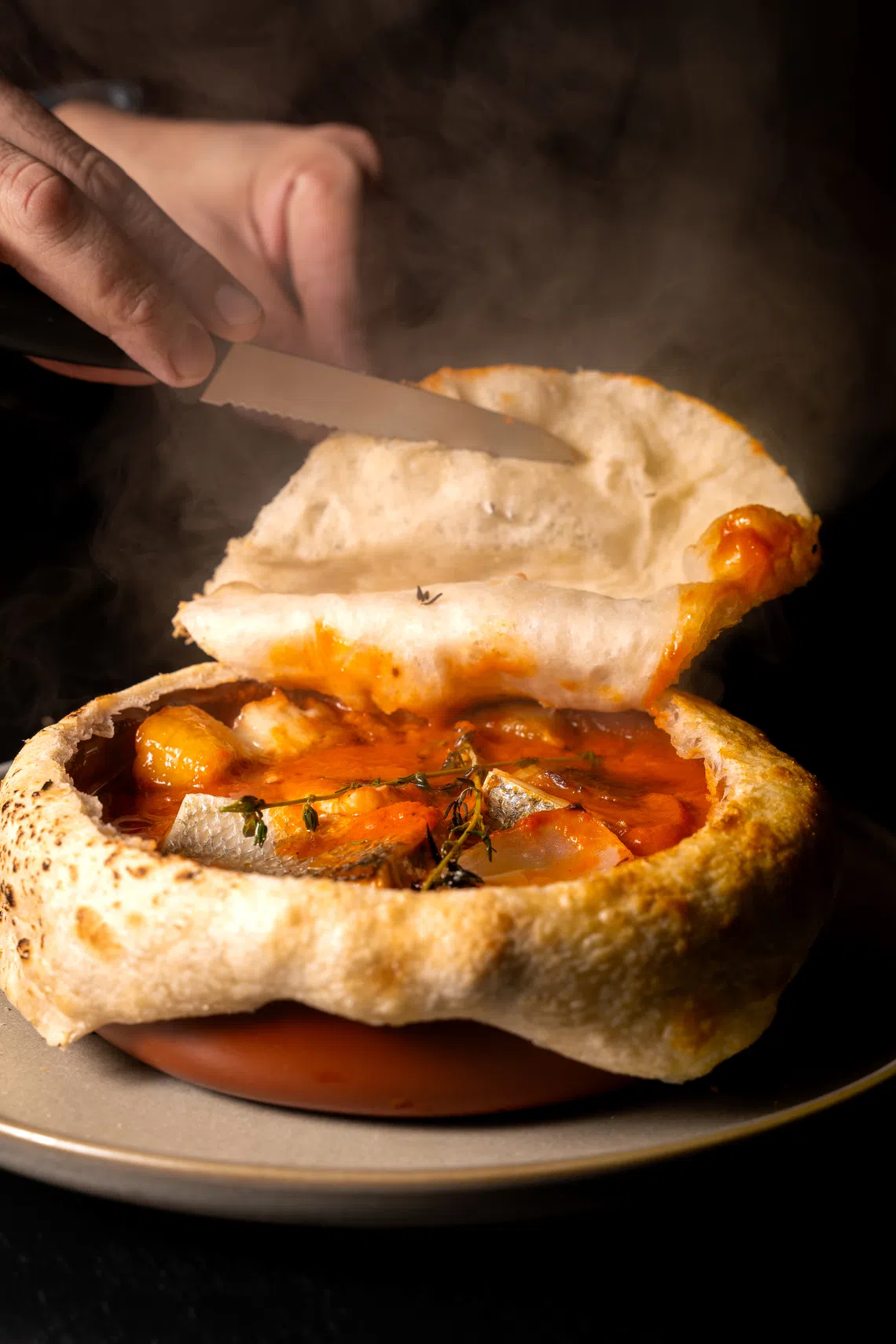
Tajin Halabi from Aniba, which serves Mediterranean Arab cuisine with European flair and Asian flavours.
PHOTO: ANIBA
Aniba, a restaurant in Boat Quay, is the product of a rich tapestry of Middle Eastern and Mediterranean influences, in the words of its Arab-Muslim head chef Anas Shami, 34. Aniba’s identity, he argues, is not his, but something more flexible.
“We celebrate the interconnectedness of the region’s cuisines, recognising how trade routes and shared ingredients have created beautiful overlaps in flavour profiles.”
He sums up his cooking thus: Mediterranean Arab cuisine with European flair and Asian flavours – a way for his team to honour the past while embracing their present location.
The result is dishes such as Aniba’s Fiiiish Kebab ($54++), seasoned with Middle Eastern spices, wrapped around a lemongrass branch and served on handmade Moroccan couscous with a housemade tomato curry sauce.
To chef Shami, this recipe embodies the soul of the restaurant. “It marries the tradition of kebab and couscous with the fresh aroma of lemongrass and subtle curry notes, showcasing the natural connection between Middle Eastern and Asian influences,” he says.
Such sophistication, he hopes, will set him apart from the rest of the pack. “You can find hummus everywhere, especially in Arab Street. But when you bring this world together, you get something more interesting, you experience the flavours in a different way.”
To underscore its cosmopolitan approach, the new menu, launched in August, drops any mention of specifics. “Port of Acre”, for one thing, is now simply “cod”, shifting the focus from provenance to the ingredients themselves, so chef Shami says.
Leila, a new entrant in Teck Lim Road that fuses Balkan and Middle Eastern cuisines, echoes a similar ethos. It is modelled after a fictional muse: the alter ego of co-founder Yogev Vardi’s Serbia-born grandmother.
Unlike the late matriarch, “Leila” is young, wild and unapologetic. She feasts on bold food that muddies the familiar – Balkan bruschetta ($19++), for example, is jazzed up with anchovies and roasted eggplant cream.
The classic Jordanian dish, Mansaf, is barely recognisable here, save for its name. Leila’s Manseef ($33++) swops out the traditional rice and lamb for spiced chicken, harissa and hummus.
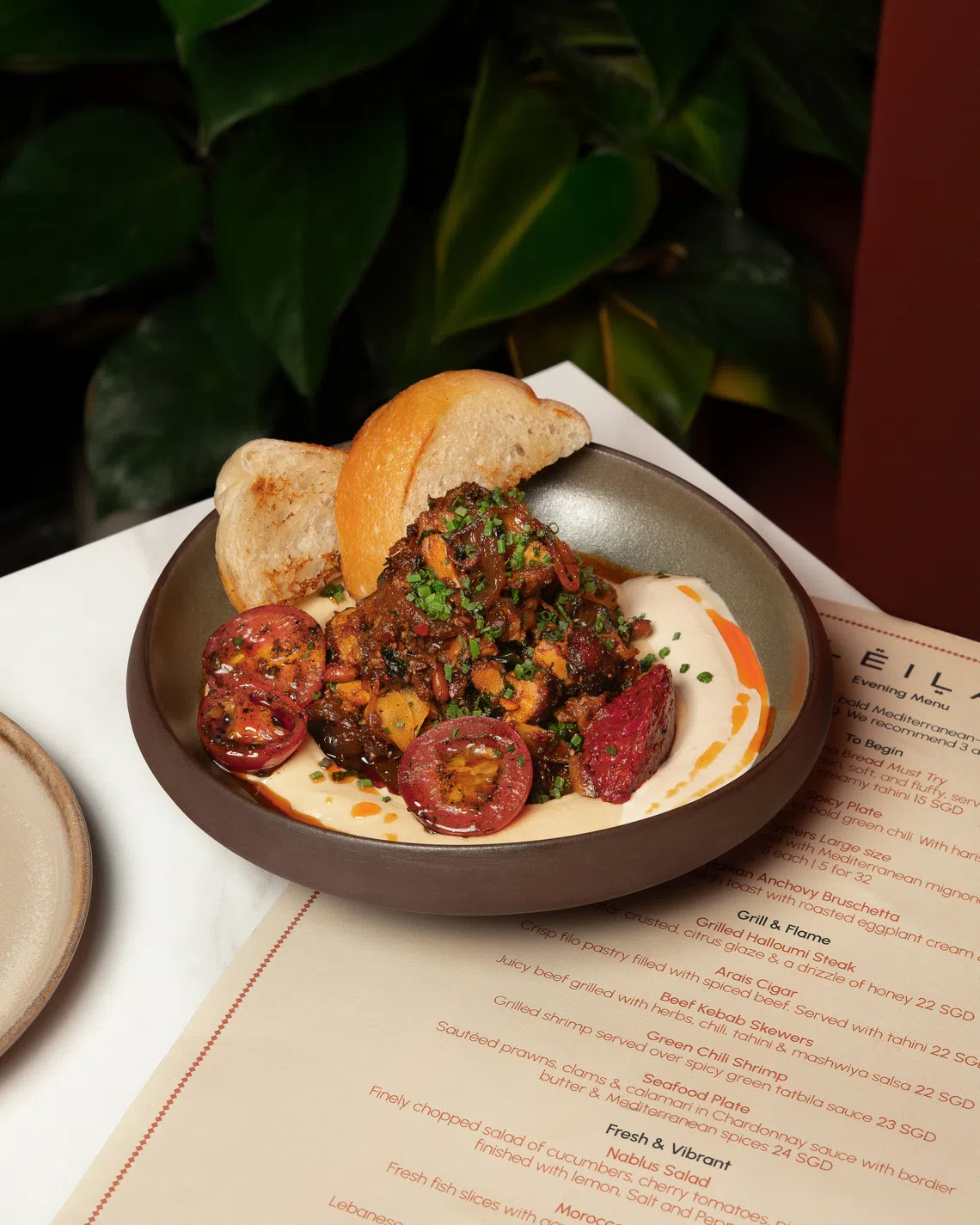
Leila’s Manseef swops out the traditional rice and lamb for spiced chicken, harissa and hummus.
PHOTO: LEILA
Mr Vardi, who has lived in various Middle Eastern countries, felt that Balkan food was underrepresented in Singapore and wanted to inject the liveliness he experienced in the region into the local dining scene.
“It’s about putting people together around the table to be able to laugh into the small hours of the night, to have fun with loud music,” says the 38-year-old, who has French Moroccan, Serbian and Croatian heritage.
As the regions connecting Asia and Europe, he felt that marrying Balkan and Middle Eastern food made perfect sense.
Over at Fat Prince, a Peck Seah Street restaurant that until mid-October was known as The Prince, the genteel royal has left the building and the old hedonist is back, gleeful and girthy as ever. Like Leila, his raison d’etre is having a grand old time.
The vibrant colour of yesteryear will return to the restaurant in phases from January 2025, but the menu has already brought back the sharing plates of the original Fat Prince, first established under that name in 2016, and rebranded in early 2024.
While the restaurant leaned more towards Turkish cooking in its early days, its current cuisine, characterised as “Middle Eastern soul meets Mediterranean vibrancy”, is deliberately vague.
“We knew we couldn’t represent one cuisine in the way that people would have expected us to represent it, so we wanted to also give ourselves the room to be creative with Middle Eastern food,” says Mr Rohit Roopchand, 45, co-founder of The Dandy Collection, the group that runs Fat Prince.
Besides, the Singaporean palate, he thinks, is not yet adventurous enough to appreciate provincial granularities.
“If you go to London, for instance, you can represent Middle Eastern food as very regional – there’s Turkish, there’s Iranian, there’s Syrian. Whereas in Singapore, that’s a bit harder to do. I don’t think there’s been enough Middle Eastern food in Singapore for people to know what the differences are.”
Over time, Mr Roopchand adds, the restaurant will get a better sense of which direction its food is headed in. But for now, it is happy to bask in this blurry whirlwind of sound and flavour, the jolly decadence of a night fit for a prince.
Four places to get your Middle Eastern fusion fix
Wewa
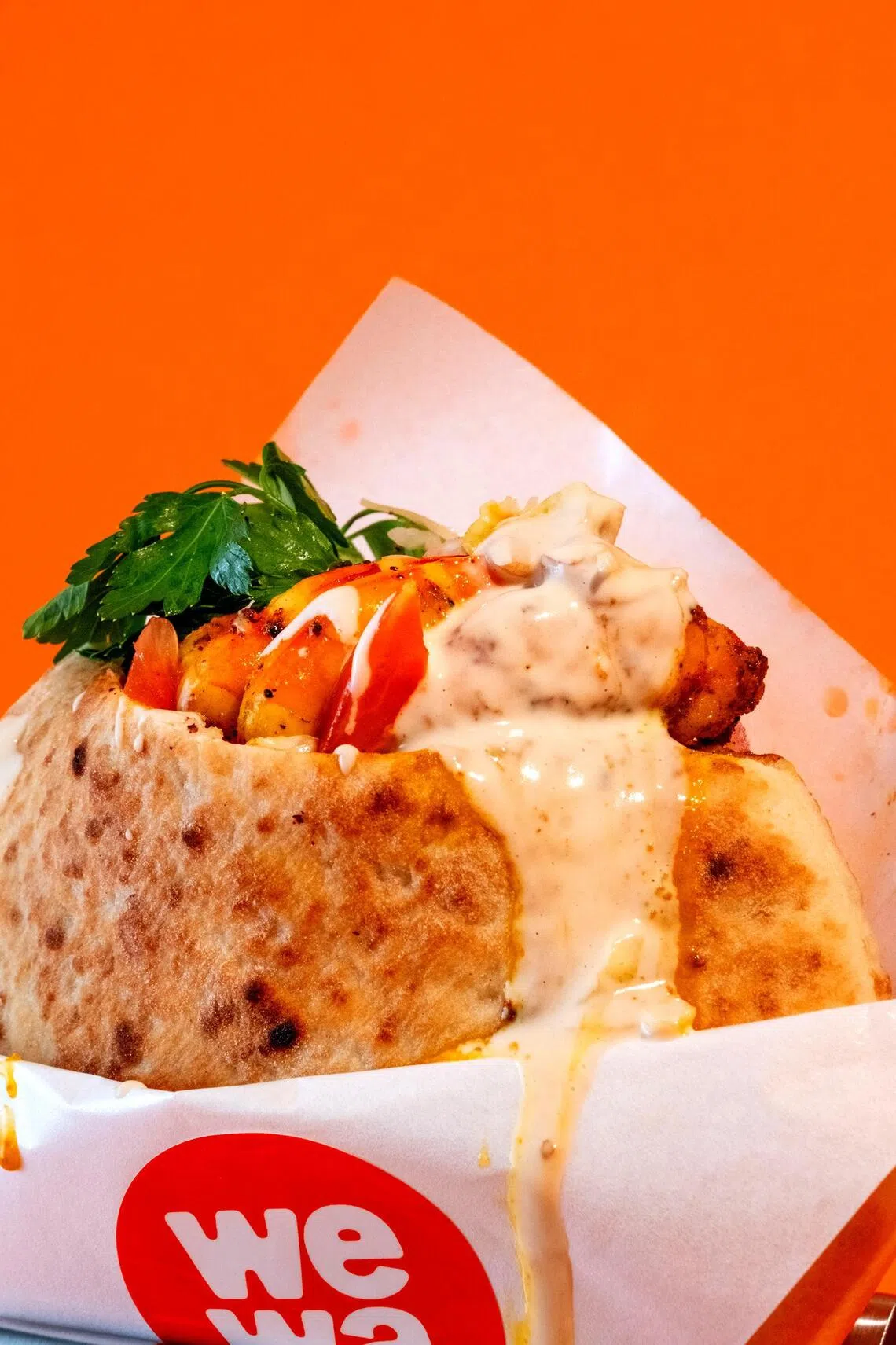
Prawn pita from Wewa.
PHOTO: WEWA
Where: 01-17 Orchard Gateway, 277 Orchard Road; 01-219/01-231 Weave at Resorts World Sentosa, 26 Sentosa Gateway; 01-151 to 154 Square 2, 10 Sinaran Drive wewantwewa.com
Open: 11am to 10.30pm daily (Orchard Gateway); 10am to 10pm daily (Weave and Square 2)
Info:
Though quick-service chain Wewa prides itself on serving authentic Middle Eastern street food, it feels no need to drill down into specifics.
Its menu does not adhere to the cuisine of any one nation, but is instead “curated to reflect the rich culinary heritage of the region”, says Ms Wani Madelina, 32, head of the Wewa Startup Team.
She adds that each element of the menu pays tribute to a different part of the Middle East. Pita bread, for instance, originates in the Levant and Eastern Mediterranean, while chicken shawarma is popular across countries such as Jordan, Egypt and Syria.
Then there are the more experimental options like prawn shawarma, which is the brand’s way of blending “Asian seafood sensibilities with Middle Eastern spices and marinades”.
Here, proteins are served with accompaniments such as tahini, harissa and amba, as well as green chilli with cilantro and garlic, and can be enjoyed in a junior pita ($6 to $8), full-sized pita ($11 to $14), keto bowl ($11 to $14) or rice bowl ($11 to $14).
Aniba
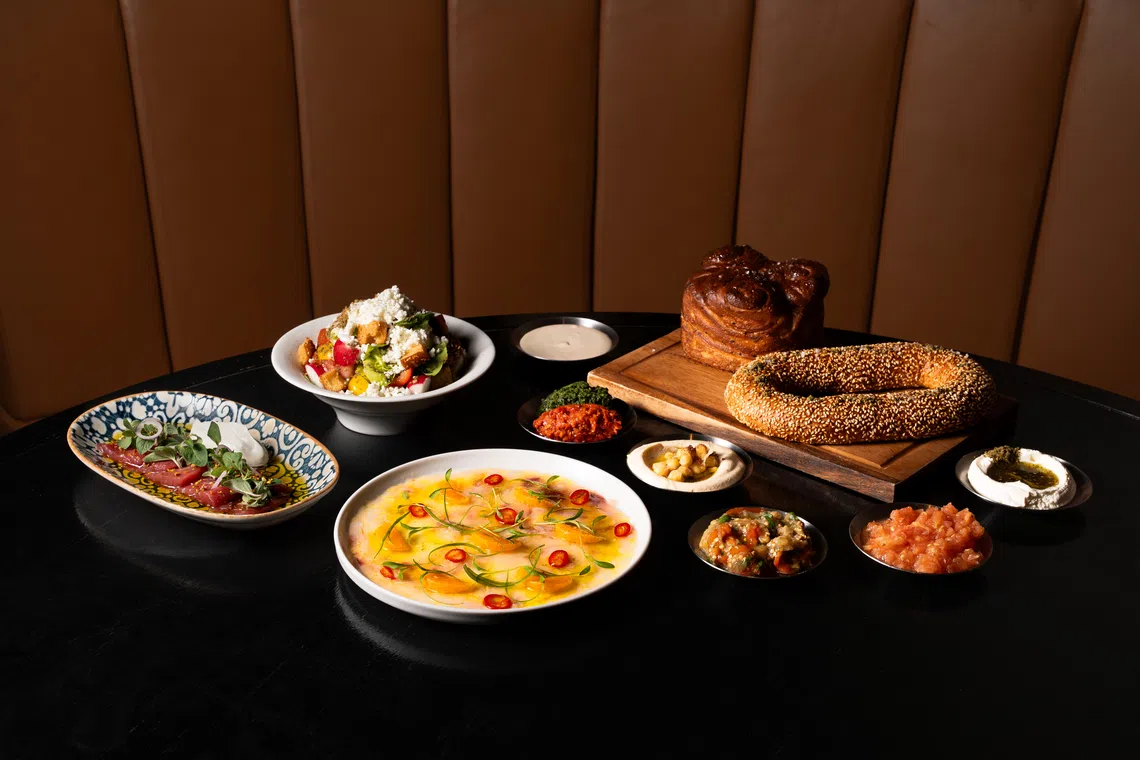
Aniba describes its food as Middle Eastern Cuisine with European style and Asian influence.
PHOTO: ANIBA
Where: 05-03, 6 Battery Road aniba.com.sg
Open: Noon to 3pm, weekdays; 5pm to midnight, Mondays to Thursdays; 6pm to midnight, Fridays; 7.30pm to 2am, Saturdays
Info:
Over the last three years, the menu at Aniba has been streamlined. Gone is the $148++ 10-course omakase set and a la carte menu with $89++ Turbot de Paris and $84++ seabass.
Dishes are now grouped into three sections – dine, bites and breads – costing no more than $72++ for a whole lavrak, or sea bass.
The lower price point has made Aniba more accessible, says head chef Anas Shami, 34.
“A couple might share some bites and bread for a casual evening, while a larger group can indulge in the full dining experience. The pricing becomes more democratic. Guests do not have to commit to a full tasting menu if they simply want to experience our flavours.”
The demographic of guests has shifted too. It is no longer just a place to visit on special occasions. Aniba now welcomes more young professionals popping in for after-work drinks and bites, families looking to share dishes and foodies eager to dine at the chef’s counter – an experience unique among Middle Eastern restaurants in Singapore.
Leila
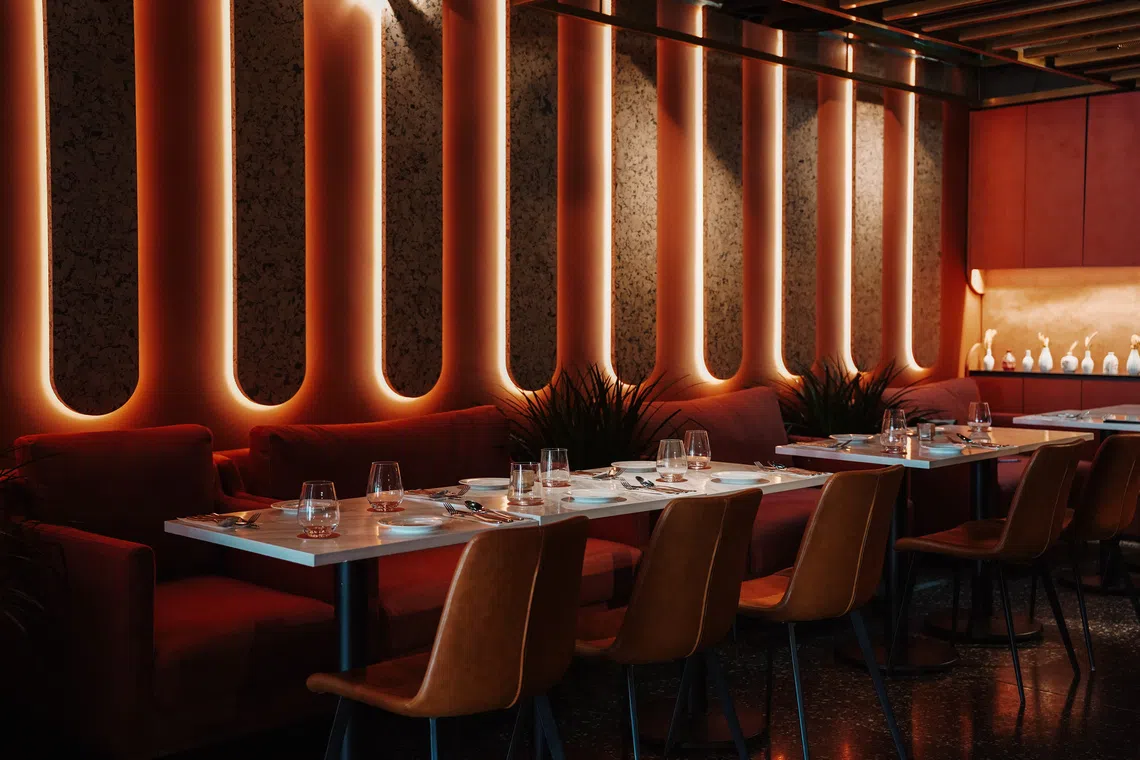
The team behind Leila is all about bold flavours and colours.
PHOTO: LEILA
Where: 12 Teck Lim Road leilasingapore.com
Open: 6pm to 1am, Tuesdays to Saturdays; 10am to 5pm, Sundays
Info:
Dinners at Leila are loud affairs, from the bold terracotta walls to the tambourine-scored birthday celebrations.
Co-founder Yogev Vardi has lofty ambitions for this establishment, which blends Balkan and Middle Eastern influences. He envisions it not as a restaurant, but as an extension of one’s living room.
Come as you are, he says, shorts and all. Grab a drink, grab a plate and dance.
The food menu was developed together with chef Mae Domingo, 33, who hails from the Philippines. She made sure the dishes have been tailored to the Singaporean palate, adding a pinch of spice to offerings like the aptly named Spicy Plate ($13++), a trio of peppers with harissa and garlic confit.
Other highlights include the Green Chilli Shrimp ($23++) and Grilled Halloumi ($22++) with a za’atar crust, citrus glaze and drizzle of silan or date honey.
Fat Prince
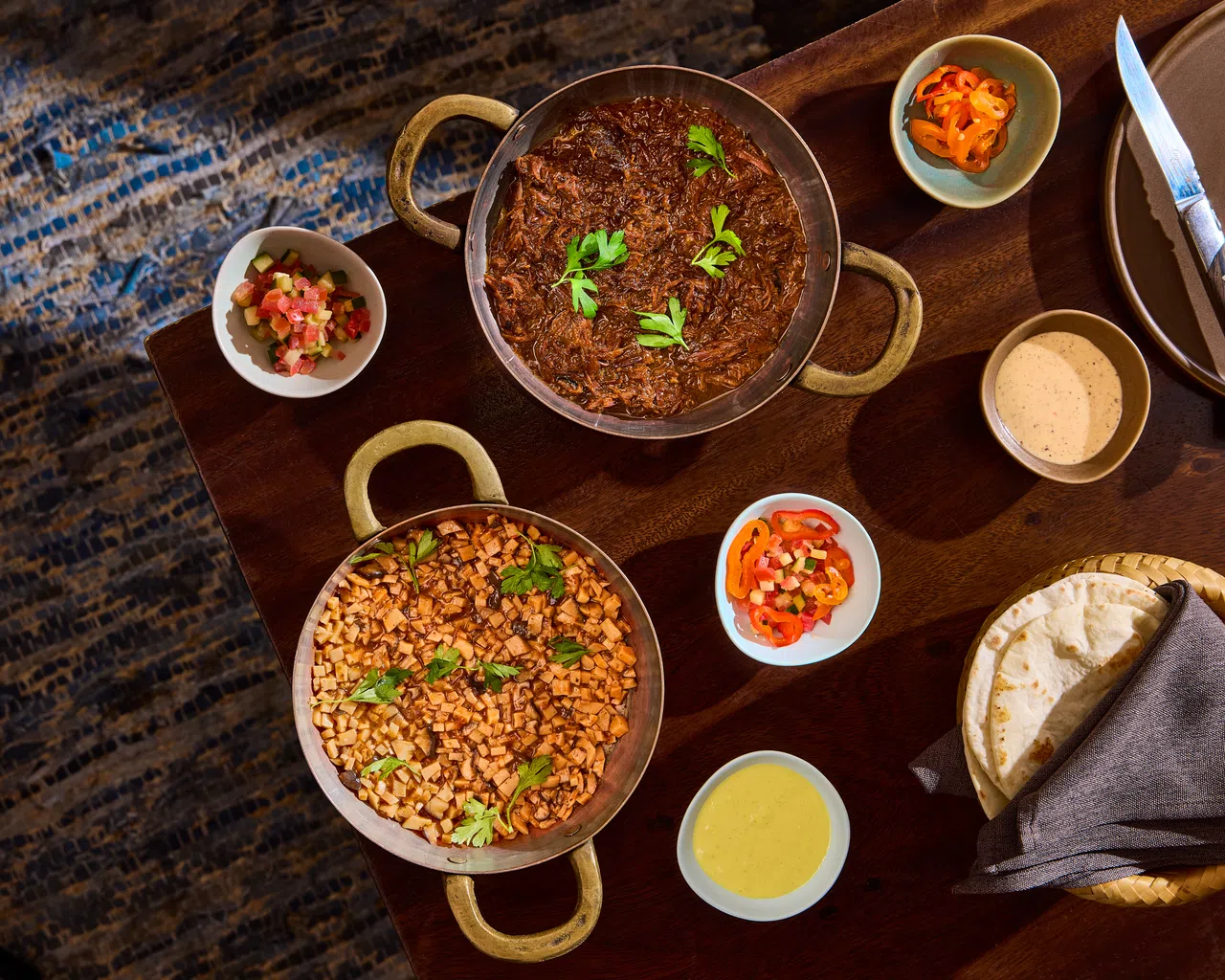
Build-It Kebab with mushroom and beef cheek from Fat Prince.
PHOTO: FAT PRINCE
Where: 48 Peck Seah Street fatprincesg.com
Open: Noon to 2.30pm, weekdays; noon to 3pm, weekends; 5.30 to 11pm daily
Info:
Life in the fast lane of Singapore’s food scene can be ruthless, and relying on taste and smell alone will not get you very far.
As restauranteur Rohit Roopchand will tell you, hearing is an equally important sense. “We cannot afford to be tone-deaf, especially in this market,” says the 45-year-old co-founder of The Dandy Collection, which runs Fat Prince.
What the people want, the people get. And what they want, in this instance, is the return of Fat Prince.
And so, out with the courtly finery. It is time to strip back the layers of polish, bust out the big plates, and turn up the music. The Build-it Kebab (from $32++) section, popular among fans of the original Fat Prince during its eight-year run from 2016 to 2024, is making a comeback, along with mezze such as cashew hummus ($14++).
The old guard is flanked this time by new dishes, such as the Moroccan Chicken Tagine ($48++) and Lamb Porterhouse ($18 per 100g). In addition to the four-course weekday set lunch ($29++), a bottomless brunch ($48++) promotion has been added to the menu, available on weekends.
Toasting to tradition
Other Middle Eastern cooks, however, are sticking to their guns, even though marketing their food as Turkish or Lebanese might not immediately ring a bell with diners looking for an approximate rundown of the Middle East’s greatest hits.
For Mrs Ozlem Ozbilgili, owner of 27 Mezze Bar & Grill at Robertson Quay, it is about plugging a gap in the market for the kind of Turkish cooking she remembers from home.
“Arab Street has a lot of Turkish restaurants, but they are kind of a mix of Turkish and Middle Eastern cuisine,” says the 42-year-old from the southern Turkish city of Adana.
In particular, she wants to show Singaporeans what an evening at a Turkish meyhane (“wine house”) looks like, lubricated by shots of raki (Turkey’s national alcoholic drink, made with 45 per cent alcohol) and plates of kebaps.
The menu at her restaurant, though strictly capped at 27 items, tries to cover as wide a swathe of Turkish cuisine as possible, drawing from seven regions, each with its own unique culinary traditions.
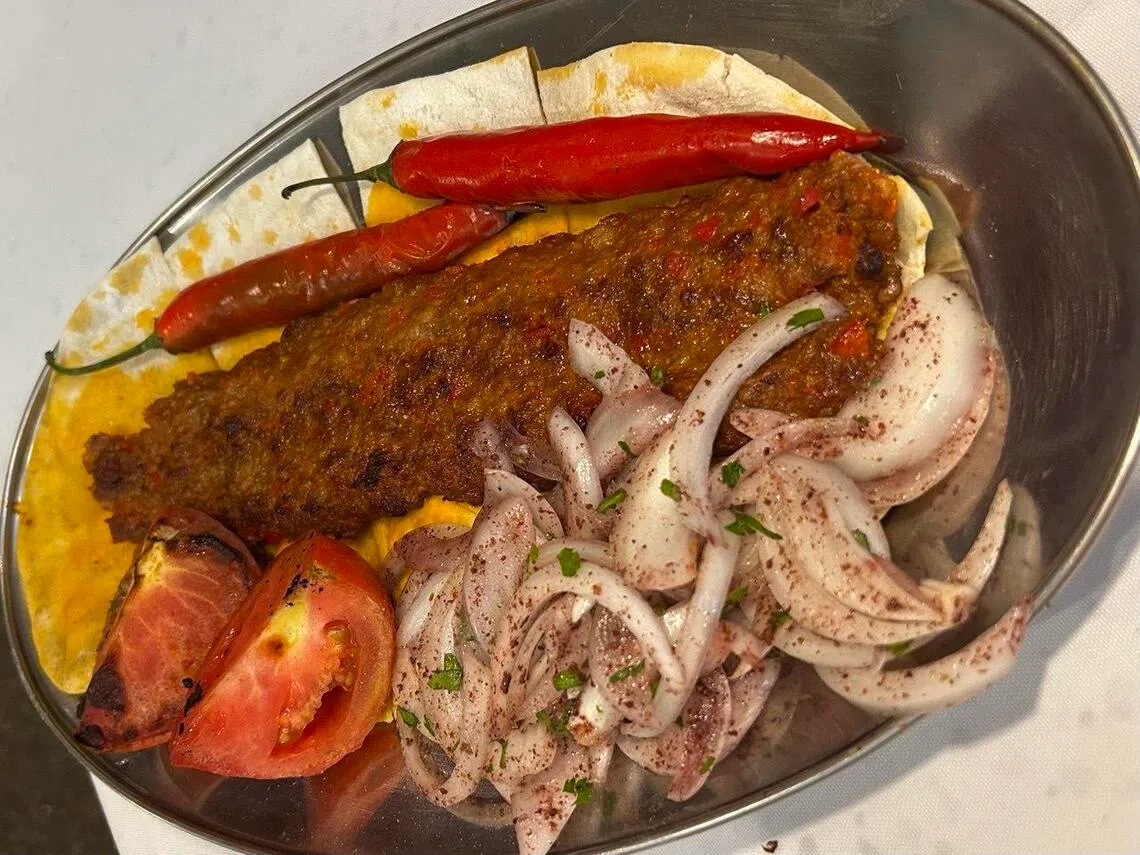
Adana Kebap from 27 Mezze Bar & Grill.
ST PHOTO: CHERIE LOK
From her home town comes a lamb kebap ($37++) seasoned with only salt and ground paprika, unlike the heavily spiced iterations of other regions.
Her deep-fried beef dumplings ($32++) are a nod to the country’s Central Asian heritage, while the keskek ($28++), or barley risotto with mushrooms, celebrates one of Turkey’s oldest dishes.
If Turkey alone contains such multitudes, how much more so the rest of the Middle East?
Jordanian chef Hana Madanat emphasises that Middle Eastern food is not a monolith. While staples like falafel and hummus transcend borders, there are subtle differences in the ways certain dishes such as shawarma are prepared.
“These countries have their own traditions, their great-grandmothers have poured their hearts into these dishes. So I, as a Jordanian, cannot say, for example, that I grew up with kibbeh nayyeh, which is a raw meat kibbeh from Lebanon,” says the 52-year-old Netherlands-based chef. She lived in Singapore for six years and is a guest instructor at Palate Sensations Culinary School in Biopolis Road.
She also emphasises that it is important to credit each country properly for its speciality dishes. Take, for instance, musakhan, a traditional Palestinian dish of roasted chicken baked with sumac, pine nuts and other spices, served over taboon bread, which is also popular in Jordan.
“The best people to cook musakhan are Palestinians,” she concedes with a laugh. Jordanians, on the other hand, lay claim to mansaf, a rice dish with lamb and jameed, a fermented yogurt.
She likens it to the ways in which Asian food is categorised here – not as generically continental, but as Japanese, Korean, Vietnamese, Chinese and so on.
As understanding of life in the Middle East increases with exposure on social media and travel to the region, she says that Singapore can afford to embrace a more diverse range of cuisines.
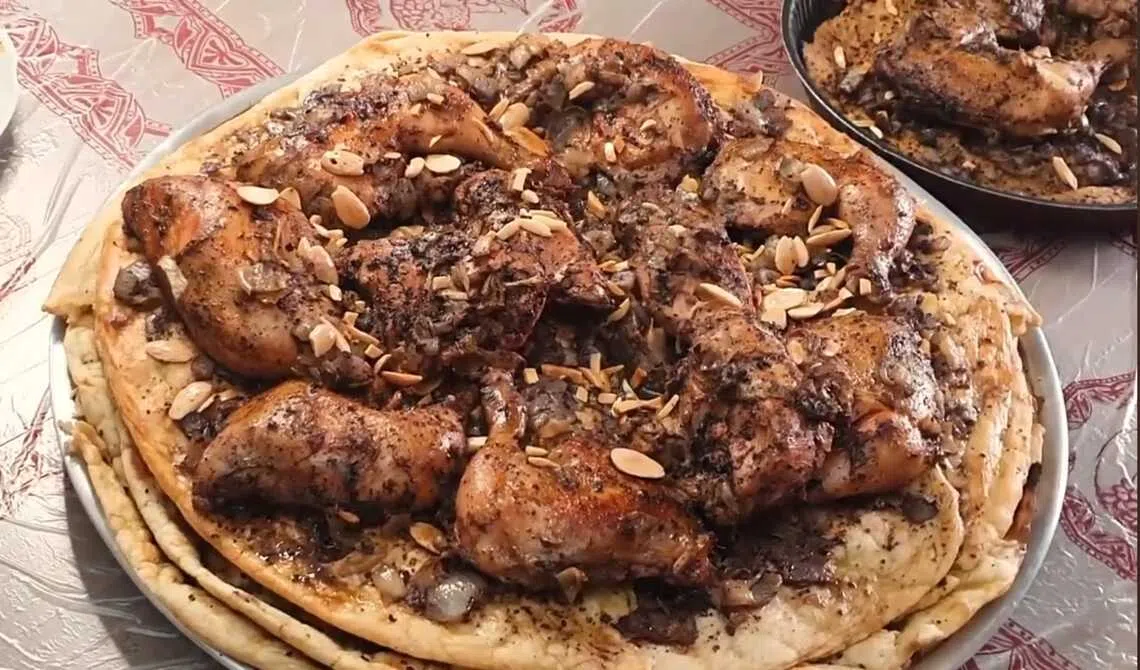
Musakhan, a Palestinian dish prepared by homemaker Nadeen Alsamah.
PHOTO: COURTESY OF NADEEN ALSAMAH
Mrs Nadeen Alsamah, 37, a Palestinian homemaker who has lived in Singapore for seven years, shares this hope for greater regional specificity. “It would be lovely to see a Palestinian restaurant that serves our breakfast and things like musakhan, for example.”
She has not been back to Jerusalem, where her family still lives, in 13 years, and stays connected to her culture by cooking traditional dishes for her two children, aged 14 and 11, with spices and herbs sent over by her mother.
With Singaporeans starting to grow more familiar with Palestine, she says she would love to share more about the food of her homeland. “Palestine is so much more than just a war,” she says.
Old food, new menus
These traditional Middle Eastern restaurants have introduced new promotions to attract diners interested in getting a taste of their culture.
Ummi Lebanese Dining
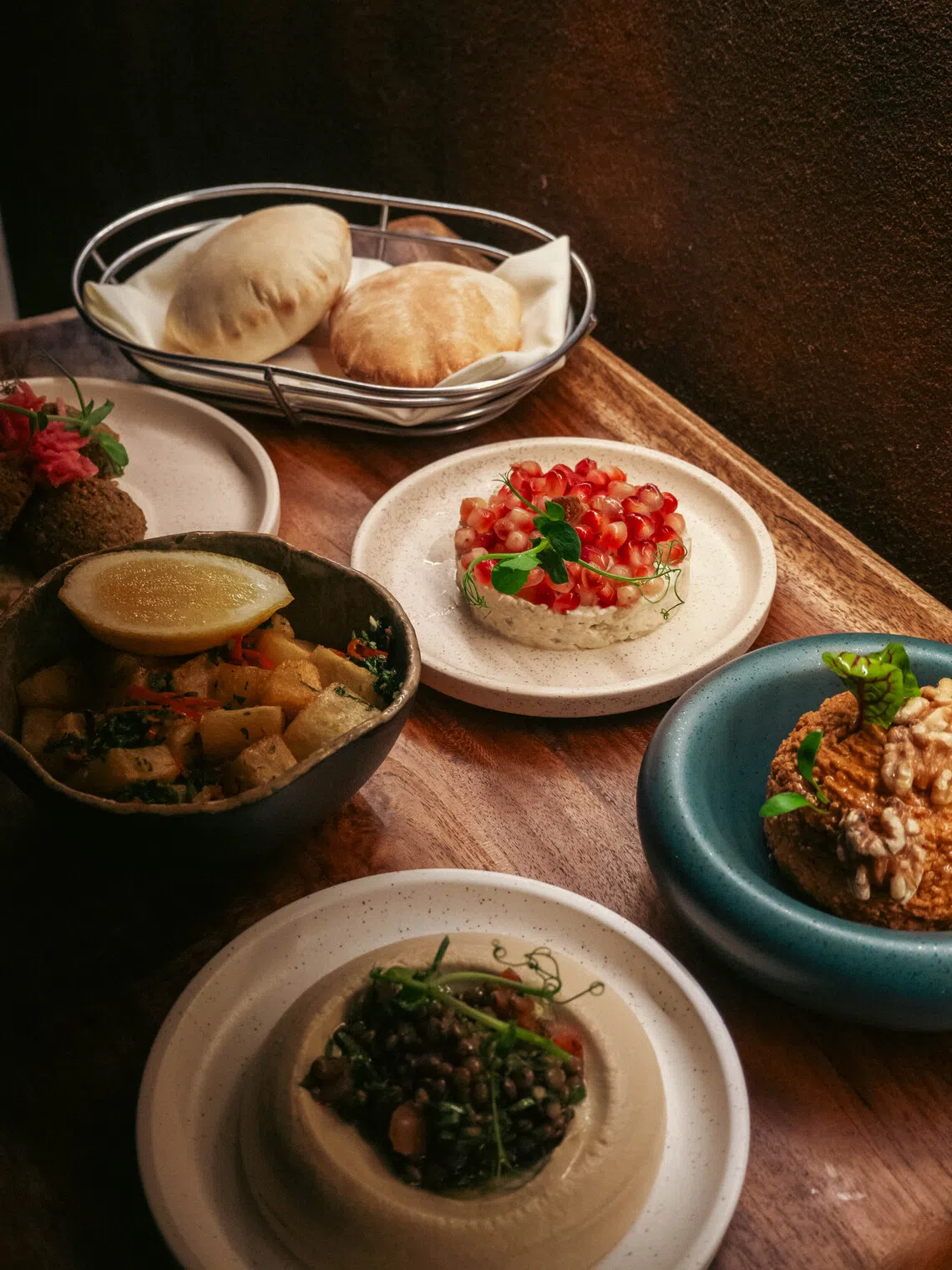
Mezze from Ummi Lebanese Dining.
PHOTO: UMMI LEBANESE DINING
ummi.com.sg
Where: 1 Nanson Road, InterContinental Robertson Quay
Open: Noon to 3pm, Tuesdays to Saturdays; 6 to 11pm, Mondays to Saturdays
Info:
Ummi, a Lebanese restaurant in Nanson Road, derives its name from the Arabic word for mother. It is mothers, after all, who inspire its code of warm hospitality, and it was head chef Ali Assaf’s mother who taught him to cook.
“I was trained by my mother and my grandmother, so I wanted to make something for the women to appreciate them,” says the 28-year-old Lebanese chef.
He is paying tribute to these matriarchs through a Ladies Lunch set menu, priced at $38++ a person for a minimum of two female diners. Because, according to him, women tend to appreciate lighter lunches with varied options, he has curated a menu that focuses more on mezzes than mains.
The meal opens with hummus, muhammara – a dip of roasted red capsicum, chillies and walnuts – mashed eggplant, crispy potatoes, chilli tiger prawns and fattoush salad.
Next, they can pick one main to share (two diners to a main) from a selection of Chicken Tawook, Lamb Kofta, pan-fried Barramundi and Eggplant Moussaka, before receiving the dessert of the day and a cup of Lebanese tea.
The new promotion, available from noon to 3pm on Tuesdays to Saturdays, has helped to boost footfall by around 10 per cent. It is an encouraging uptick for the chef, who hopes Lebanese food in Singapore will enjoy wider appreciation.
“Who knows, we might see a Lebanese restaurant on the Michelin Guide in Singapore one day,” he says.
27 Mezze Bar & Grill
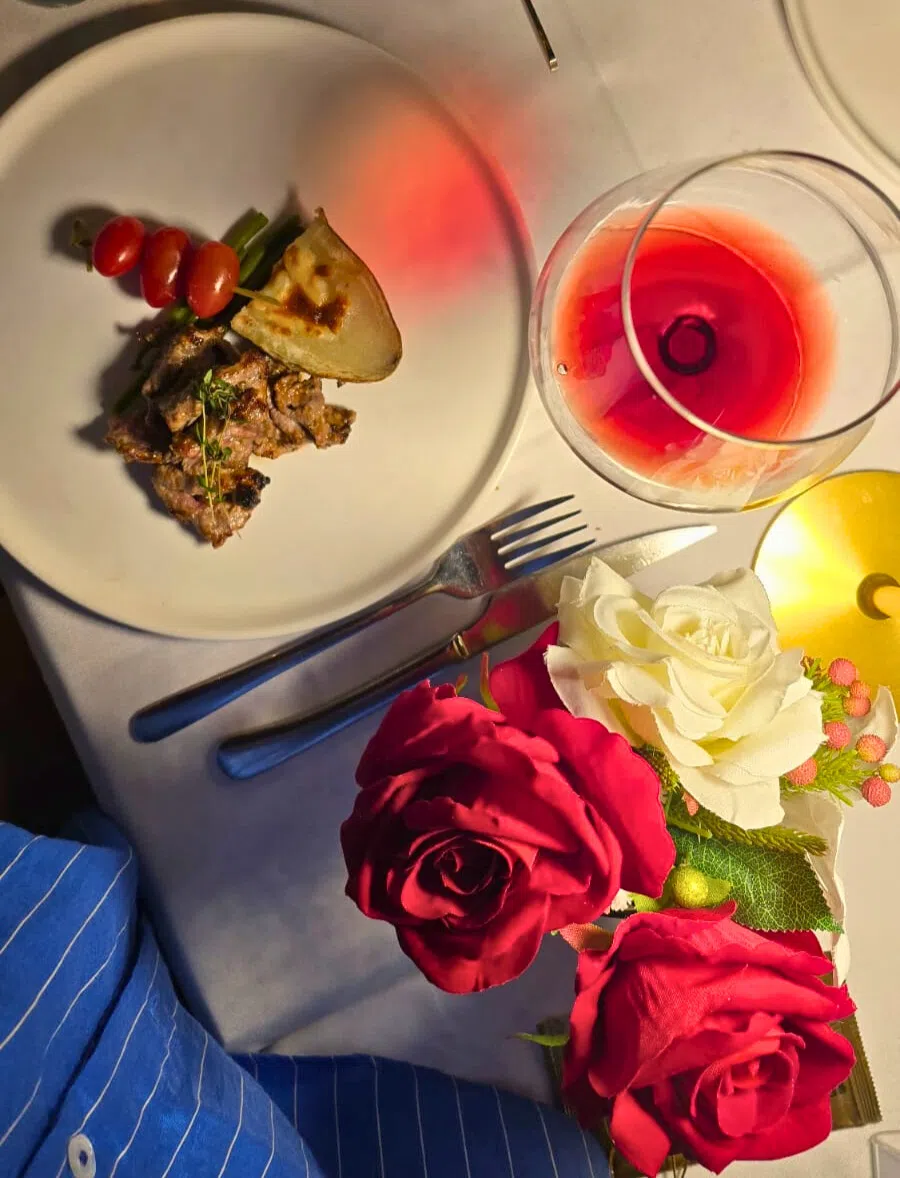
27 Mezze Bar & Grill has introduced a wine tasting menu on Mondays.
PHOTO: 27 MEZZE BAR & GRILL
Where: 01-02A Riverside View, 30 Robertson Quay 27mezzebarandgrill.com
Open: 6 to 11pm, weekdays; noon to 11pm, weekends
Info:
A night out at a Turkish meyhane is not complete without a bit of booze. The term itself demands it: Meyhane literally translates to “wine house”.
Mrs Ozlem Ozbilgili, owner of 27 Mezze Bar & Grill, has not yet found a viable way to import Turkish wines to Singapore because of limited demand, so she has rustled up the next best thing.
In October, she rolled out a tasting menu of European wines at her Robertson Quay restaurant, each glass designed to complement a traditional Turkish dish. The four-course dinner, which is available on Mondays and costs between $40++ and $50++ a person, changes weekly.
It could, for instance, pair a Pinot Grigio from Italy with hummus and pita bread. Or a glass of Tempranillo, a red wine from Spain, might accompany a plate of chicken skewers.
“We love wine from different countries, and we wanted to see how it works with our food,” says the 42-year-old Turkish restaurateur.
“It’s an exciting thing to do, and in this F&B environment, I think it’s a good thing to partner other businesses. You need to offer customers something more without completely flying away from what you’re known for.”


